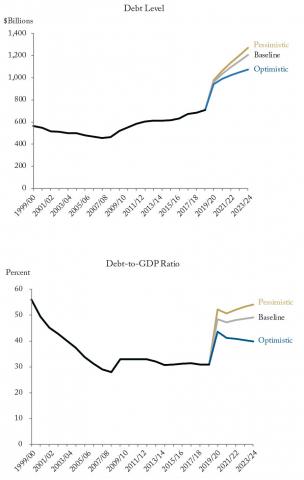From: Alexandre Laurin, Miles Wu and William B.P. Robson
To: Canadians Concerned about Government Debt
Date: May 13, 2020
Re: Net Federal Debt Heading for $1 Trillion
However necessary and welcome the federal government’s transfer payments and credit-market supports may have been on the way into the COVID-19 crisis, it is becoming clear that we cannot afford this level of spending for as long as the coronavirus may be with us.
Ottawa needs to rein in its spending and borrowing – if only so that provincial governments, who have the heavier lifting to do as their healthcare systems adapt, will have the tax and borrowing room they will need.
Precise numbers are out of reach at the moment. We don’t have a good handle on the economic impact of COVID-19 and the measures to contain it, and the federal government is announcing new measures – typically with price tags in the billions – almost daily. What is clear, however, is that Ottawa’s net debt is headed for the previously inconceivable level of $1 trillion.
In its latest update, the Parliamentary Budget Officer (PBO) laid out a “most likely” fiscal scenario for 2020/21, yielding a possible $252 billion deficit – which, overlaid on the PBO’s economic baseline, results in a jump of more than 10 percentage points in the federal debt-to-GDP ratio in one year. Taking that as a starting point, we computed a range of economic scenarios for years 2020 and 2021 – baseline, optimistic, and pessimistic – using as a guide the range of GDP forecasts provided by the Bank of Canada in its April monetary policy report, and new economic information released since then. For the years 2022 and beyond, we assume GDP growth from the pre-COVID December federal fiscal update (Fall Update).
Historical and Projected Federal Debt Scenarios, 2020/21 to 2024/25
Source: Authors’ calculations based on PBO’s analysis, the Fall Update, and the Bank of Canada.
Tax revenues in our projections grow in line with nominal GDP. For 2020/21, we assume they come in at the PBO’s projected share of GDP. Beyond 2020/21, they return, over two years, to their Fall Update share of GDP. Other revenues follow the PBO for this year, and the Fall Update beyond this year – except for EI premiums next year, which we assume to be lower because of a weaker labour market.
Most program expenses also follow figures from the PBO this year, and the Fall Update later. We adjust EI benefits because of higher projected unemployment. Debt charges are higher, reflecting the larger debt. Most importantly, we assume that all spending measures announced this year do not extend into the future.
The striking result is how much red ink the federal government shows in all scenarios, long after temporary income supports such as the CERB and the CEWS have ended. Without major changes, Ottawa’s net debt will shortly hit $1 trillion. In our baseline scenario, we project deficits of $73 billion next year, and more than $50 billion per year from 2022/23 to 2024/25. The federal debt reaches 49.1 percent of GDP by 2025.
In our optimistic scenario, the government runs deficits of $232 billion in 2020/21 and $46 billion next year. By 2024/25, the federal debt reaches about 40 percent of GDP. Our pessimistic economic scenario starts with a deficit of $266 billion this year, $85 billion next year, and still almost $70 billion by 2024/25, by when the federal debt hits 54 percent of GDP.
To repeat, none of these scenarios allows for extension of existing income supports. Nor new ones. Nor the stimulus packages governments always resort to after slumps. Add those in, and the deficits and accumulated debt could be $100 or even $200 billion higher by the end of the period.
If Canada were a unitary state, and Ottawa the only government that mattered, increases in debt like this would be unsettling, but manageable. Canada is not a unitary state, however, and although the federal government and its massive new programs are filling the headlines, the really hard work ahead is at the provincial level.
It is the provinces, whose health budgets were already under pressure from an aging population and rising costs of care, that will be on the front line. They will carry most of the loads of testing, remedying the grievous gaps the pandemic has revealed in seniors’ homes, providing acute care, ensuring that COVID-19 does not further pre-empt other treatments – and, we can hope, one day overseeing vaccination against the virus.
Provinces are also borrowing, and by mid-decade, provinces will be looking for tax room to meet these demands. That is why $1 trillion in federal debt is a problem, and why the federal government needs to change course. As Canada makes the adjustments it requires for a post-crisis world, federal spending and borrowing have to come down. Ottawa needs to get out of the way.
Alexandre Laurin is Director of Research, Miles Wu is Research Assistant, and William B.P. Robson is President and CEO, at the C.D. Howe Institute.
To send a comment or leave feedback, email us at blog@cdhowe.org.
The views expressed here are those of the authors. The C.D. Howe Institute does not take corporate positions on policy matters.






